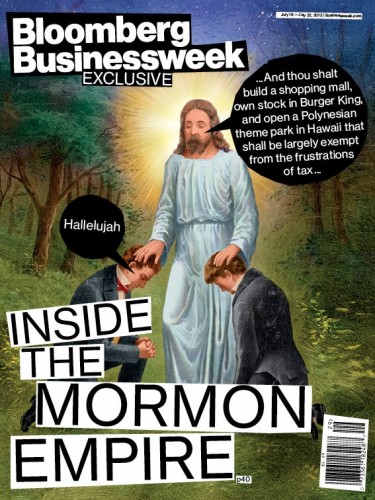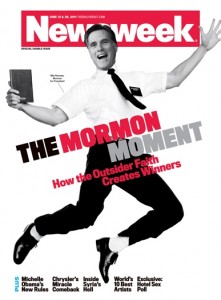 I am certainly not the first to note this, so let's all say this together: What were the editors at Bloomberg Businessweek thinking? Basically, its cover story about the Church of Jesus Christ of Latter-day Saints' finances could offend just about anyone who practices just about any kind of faith.
As Daniel Burke from Religion News Service reports:
I am certainly not the first to note this, so let's all say this together: What were the editors at Bloomberg Businessweek thinking? Basically, its cover story about the Church of Jesus Christ of Latter-day Saints' finances could offend just about anyone who practices just about any kind of faith.
As Daniel Burke from Religion News Service reports:
A lengthy story in Bloomberg Businessweek that hits newsstands on Friday details The Church of Jesus Christ of Latter-day Saints' vast financial holdings, from a $2 billion mall in Salt Lake City to a $1 billion ranch in Florida.
Reaction to the magazine's cover has overshadowed the article, however. The illustration satirizes the moment when Mormons believe John the Baptist bestowed the priesthood on Joseph Smith, the faith's founding prophet.
In the parody, John the Baptist tells Smith, "and thou shalt build a shopping mall, own stock in Burger King, and open a Polynesian theme park in Hawaii that shall be largely exempt from the frustrations of tax ..." Smith answers, "Hallelujah."
I like how veteran Salt Lake City Tribune reporter Peggy Fletcher Stack asks a magazine spokesperson if the cover really is real.
The cover, which has been posted repeatedly on Facebook, is real, Patti Straus, Bloomberg Businessweek spokeswoman told The Salt Lake Tribune on Thursday. ... When asked if the magazine was getting any angry reactions to the cover, Straus wrote in an email, "The story speaks for itself."
Sorry, but if you're a magazine, design and story go together, maybe not from the reporter's perspective, but from an entire editorial point of view, it shapes how you want the reader to feel.
The cover is certainly not the first offending one from a national magazine. You might recall Newsweek's 2011 cover of Mitt Romney dancing to the words "The Mormon Moment."
So how did Bloomberg Businessweek's cover come about? The Deseret News illustrates some ironies by simply quoting from Bloomberg Businessweek's art director.
"We looked into paintings of what is referred to as the First Vision, which is when Joseph Smith went into the woods and had a revelation, and since that moment founded Mormonism," Robert Vargas, the art director, said in a Bloomberg Businessweek video. "So in researching the paintings, there were many sorts of iterations of this. It's been done various different ways." ...
This one was not of the First Vision, as Vargas apparently supposes, but of the Angel Moroni delivering the gold plates of the Book of Mormon to Joseph Smith. It may be that Vargas assumed that any painting of Joseph Smith receiving a vision in the woods was part of the First Vision. ...
Vargas said the Bloomberg Businessweek editors settled on using the Christensen art "because it had this nice naiveté to it." "The image itself is somewhat serene," he added, "so we wanted to have a little more energy with the typography to balance that out." ...
Vargas called the talk bubbles of John the Baptist telling Joseph Smith to invest "funny."
Seriously, what is up with editors and designers these days?
The webpage with the story "How the Mormons Make Money" and the art they use is what looks like a gold set of praying hands (maybe depicting idolatry?) clasping money with the sun shining down through the clouds.
 Even if you move past the art, does the story really understand the Mormon faith enough to understand how it wouldn't function the same way a business would?
Even if you move past the art, does the story really understand the Mormon faith enough to understand how it wouldn't function the same way a business would?
As Joanna Brooks put it at Religion Dispatches, the story itself leaves the reader wanting more.
Another lost opportunity was Winter’s failure to pursue with any insight or curiosity the question of what motivates Mormon enterprise. It’s not that Mormonism is just another form of prosperity gospel. The faith has a 170-year-long history of seeking economic self-sufficiency, motivated at first by Mormons’ desire for autonomy from a hostile mainstream and by necessity engendered by their western isolation. Today, that drive is motivated -- as I’ve heard discussed among leading figures in Mormon Studies this week and as was hinted at in the Church’s own statement and a Deseret News editorial today -- by the need to create an endowment capable of sustaining the global physical infrastructure of Mormonism (temples, churches, universities) even as the bulk of the Church’s population shifts to the global south and tithing revenues flatline or even drop.
This is no simple Creflo Dollar morality tale. This is story about history and global patterns of wealth distribution, as well as about the way a financially successful American-based Church takes what it needs from the market to realize its own countercultural priorities. A story maybe too big for Businessweek to grasp, and certainly too big for its juvenile cover.
I was actually kind of surprised that the article didn't mention more about Mitt Romney, given how everything from reporters these days seems to be seen through presidential election lenses. This was one sentence: "Mitt Romney and others at Bain Capital, the private equity firm he co-founded in 1984, gave the Mormon Church millions’ worth of stock holdings obtained through Bain deals, according to Reuters." But generally I didn't find it to necessarily be tied to Romney.
But then the reporter did an interview with Bloomberg about her story, and the people interviewing go so painfully obvious to Romney, it's incredible. It's like the only thing matters, the only reason we should ever care about how the LDS Church handles its money is the presidential election. When the media starts to take an intense look at religion only in presidential election cycles, there's something wrong, and some priorities are out of order.
One line that did stand out for me from the reporter was when she said, "Most religions make a very clear distinction between the spiritual and the secular, and Mormons deny that there is a distinction at all. Mormons believe they are building a kingdom on earth." I know some evangelicals believe God is building a kingdom on earth, so I don't know that her broad sweeping statement about other religions vs. Mormonism is spot on. Anyone with insight into this particular theological view?
No matter how you feel about Mormonism or how leaders handle the institution's finances, if you care about the way religion is depicted in the media, you should care about this cover and this piece. There is nothing wrong, in terms of journalism, with looking at a religious group's finances if you take the subject seriously. There were definitely nuggets of information worth reading, but the designers and editors let this one fall flat.
